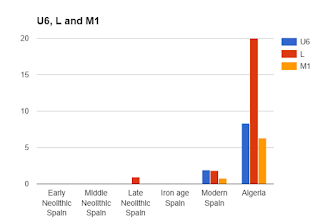

Nikitin et al. 2016 just published mtDNA results for nine members of the East European Neolithic Cucuteni-Trypillia Culture. They died around 3500 BC and were buried in the Verteba cave in SouthWestern Ukraine. The results are below...
H=4
H5*, H5b*, H1b1*, H
U8b1=2
U8b1a2b, U8b1b
T2b*=1
HV6-24=1
HV0=1
This dose of mtDNA from Cucunteni-Trypillia is made up entirely of typical Neolithic European farmer lineages. This confirms, like farmers in other parts of Europe, that they weren't simply local forgers who learned how to farm but were instead to a large extent descended of Neolithic farmers from Southeast Europe and the Near East.
As Steppe pastoralists, like Yamnaya, moved westward to Europe around 3000 BC they ran into and (probably)intermarried with the farmers of Eastern Europe, like the Cucunteni-Trypillia farmers. The genes of Eastern European farmers could have therefore been carried alongside Steppe genes to many parts of Europe during the Chalcolithic and Bronze ages.
Interestingly ancient farmers from Romania had an impressively high frequency of mHG H(about 60%). The new data from Ukraine is consistent with that high frequency of H. Four of the Nine of these Cucunteni-Trypillia farmers belonged to mHG H. Maybe farmers from Eastern Europe can help explain high frequencies of mHG H in modern Europeans. Maybe. The data doesn't strongly support this idea or storngly not support. I'm just throwing out the possibility that farmers from Eastern European contributed lots of ancestry to modern Europeans.
Not only does it appear Eastern European farmers had a lot of H but one of the Cucunteni-Trypillia farmers belonged to typical modern (Eastern)European mHG H1b. Not a single H1b exists in the about 600 mtDNA samples from Neolithic Germany, Hungary, and Spain. But today every part of Europe has at least 1% H1b. Eastern Europeans; Poles, Lithuanians, Slovaks, Bosnians, etc., have the most H1b(3-4%). Though H1b is mostly European it has also been found in the Near East, Iran, and Western Siberia
Below are the only other instances of H1b in ancient DNA...
4700-4500 YBP, Poland/Ukraine border.
1358 BC, Mongolia.
The Bronze age H1b individual from Mongolia was of mixed Eastern European and North Asian ancestry, his H1b was from Eastern Europe.





